
About the Program
Our innovative MFA program includes both studio instruction and literature courses. Writers can take workshop courses in any genre, and they can write a thesis in fiction, nonfiction, poetry or hybrid (multi-genre) form. Workshops and seminars are taught by our award-winning faculty. Program workshops and seminars engage with topics and practices of translation, inter-arts dialogue, literary editing, place-based and environmental writing, and community-based projects, among other subjects.
The program features sustained mentoring of individual projects over the second year of study. Students work closely with three readers on their project to develop their thesis. Many of our program alumni have gone on to publish books that began in their studies at UC-Davis. Graduates of the program have been published by presses such as Viking, Random House, Farrar, Straus & Giroux, Simon and Schuster, Red Hen Press, Tin House, Flatiron Books, and University of Georgia Press. Students have found careers in teaching, editing, screenwriting, journalism, community programs, and freelance writing.
We offer sustained teaching support for graduate students as they learn to teach Davis undergraduates in literature and creative writing courses. Our graduate students gain valuable pedagogical experience and develop meaningful skills through their teaching in this program.
The program hosts a series of events every year that are open to the university community and the wider public, including a renowned Reading Series. Students are encouraged to seek out courses across the university and to make use of UC-Davis’s excellent resources, from the library’s archives to the arboretum’s gardens. Our students have collaborated with artists in the UC Davis Studio Art and Music programs to produce innovative work, and regularly participate in the Manetti Shrem’s yearly Arts and Humanities Graduate Exhibition.
Our program is grounded in a belief in the power of various perspectives and experiences, the importance of artistic exploration, and the development of vivid and distinctive creative voices.
Questions? Contact:
Graduate Program Coordinator
Department of English
vmpertl@ucdavis.edu

